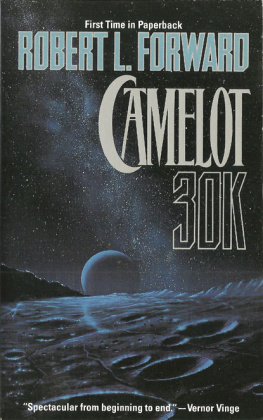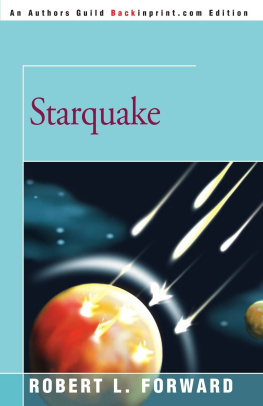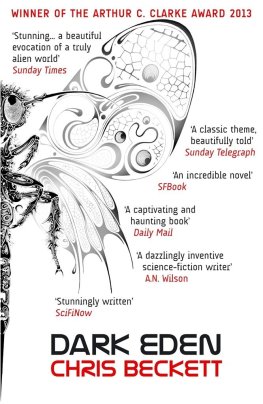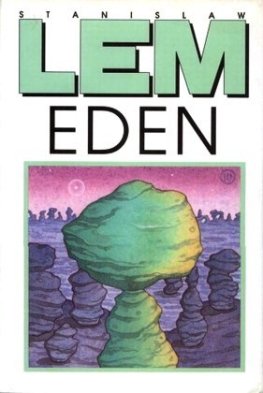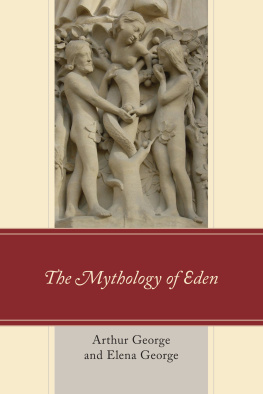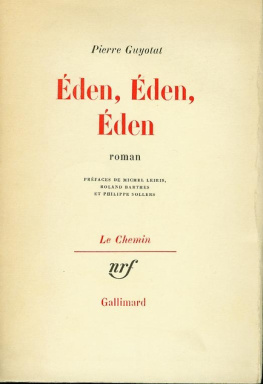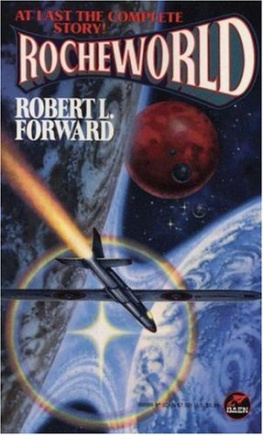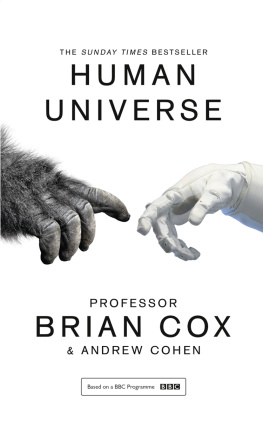MAROONED ON EDEN
Robert L. Forward
and
Martha Dodson Forward
This is a work of fiction. All the characters and events portrayed in this book are fictional, and any resemblance to real people or incidents is purely coincidental.
Copyright 1993 by Robert L. Forward & Martha Dodson Forward
All rights reserved, including the right to reproduce this book or portions thereof in any form.
A Baen Books Original
Baen Publishing Enterprises
P.O. Box 1403
Riverdale, N.Y. 10471
ISBN: 0-671-72180-1
Cover art by David Mattingly
First printing, August 1993
Distributed by
SIMON & SCHUSTER
1230 Avenue of the Americas
New York, N.Y. 10020
Typeset by Windhaven Press, Auburn, N.H.
Printed in the United States of America
ACKNOWLEDGEMENTS
The authors wish to thank the following people, who helped us in several technical areas: Julie Fuller, Seichi Kiyohara, and Gordon T. Baker, M.D.
The "Christmas Bush" motile was jointly conceived by Hans P. Moravec and Robert L. Forward, and drawn by Jef Poskanzer using a CAD system.
All final art was expertly prepared by the great gang of graphic artists at Multi-Graphics in Marina Del Rey, California.
I was feeling most upset. Intruders were disturbing my people's territoryand one of my eyes was late...
The mid-day darkness was fast approaching. All my eyes, but one, were back in their nests tucked underneath my fronds, feeding me the views they had gathered. I retired into my mind to revise my worldview. The new views coming from my eyes now contained images of strange four-limbed creatures. Somehow, the creatures managed to balance on just two limbs and didn't fall down!
My attention was next drawn to a circle of stones that surrounded the yellow horror of a fire that was blazing away in the center. These strangers must be intelligent indeed to be able to control fire!
One of the strangers was holding a stick over the fire. Impaled on that stick were a few chunks of something. The creature pulled one of the chunks off the stick and raised it to its naked mouth. I moved my view closer. Then, with revulsion and horror, I recognized the triple-jointed structure of meat and bone, and the few still-unplucked blue-green pinfeathers on the skin...
The creature was eating one of my eyes!
Other Books in This Series
Rocheworld
Return to Rocheworld
(with Julie Forward Fuller)
SAILING
Solitary and silent, the huge starship Prometheus sailed through space, propelled by the sunlight reflected from its large circular lightsail of thin silvery metal film. The 300 kilometer diameter lightsail maintained its flat circular shape by a ponderous rotation of the structure about its central axis, like a slowly cartwheeling tinfoil moon passing across the backdrop of a gigantic empty stage. Below the lightsail hung a metallic cylinder, a space habitat, somewhat the worse for the wear it had experienced over the almost half century that had passed since it had left the Solar System. In the weak light of the small red dwarf star Barnard, six light-years distant from Earth, the ship's metal exterior shone a dim, pale red.
Mechanically and efficiently, the optical telescopes, infrared imagers, particle detectors, electromagnetic receivers, neutrino counters, gravity sensors, data analyzers, information recorders, and interstellar communicators under the supervision of the powerful central computer of Prometheus performed their myriad and continuing tasks of observation, analysis, and reporting of the physical aspects and the behavior of the various bodies in the Barnard planetary system.
In close orbit around Barnard circled the gas giant planet Gargantuafour times bigger than Jupiterwith its retinue of nine moonsfour large planetoids and five small rocks. Between the circular orbit of Gargantua and Barnard whirled the strange double-planet Rocheworld in its own highly elliptical orbit around Barnard. Rocheworld's orbital period was exactly one-third that of Gargantua's orbital period, so it passed close to Gargantua once every third orbit.
All the moons and planets of the Barnard system had been surveyed from space during the first three years after the arrival of Prometheus at the Barnard system, and two of the bodies had been explored by landing parties. Rocheworld was one of the bodies that was visited, not once, but twice. Two different alien lifeforms were found there. One, the "gummies", lived in the highlands of Roche, the name given to one lobe of the double planet, and the other, the "flouwen", lived in the oceans of the other lobe, Eau. The third exploration landing had been on Zulu, the innermost large moon of Gargantua, whose ice-covered ocean contained hot-water geysers around which lived colonies of intelligent "icerugs."
Now, Prometheus approached the next landing target, the Gargantuan moon Zuni, which orbited between the water-covered moon Zulu and the smog-covered moon Zouave. A little larger than the Earth's moon, with a surface gravity of only 28% that of Earth, Zuni should have been barren and cold, or at least should have had a hostile environment like Rocheworld or the other moons of Gargantua. Instead, it looked like a miniature Earth, a South Pacific version, with verdant volcanic island chains stretched out over a planetwide blue ocean dotted with white rainclouds. Part of the reason Zuni had been chosen as the target for the last of the four planetary exploration landers that Prometheus carried, was to find out why this small moon was so Earth-like.
Within the sheltering metal hull of the space habitat, the central computer and "brain" of Prometheus, James, absorbed the data that flowed in from all over the ship, while at the same time it effortlessly monitored the condition of its equipment, operated the versatile and sensitive motiles by which it essentially ran the ship; and, at least as important, cared for and served the nineteen human beings whose lives were confined within the hull. For, although James collected and correlated the data, the real analyses and discoveries were made by the humans, who studied the information their machines had gathered about these strange planetoids, and struggled to comprehend the meaning behind the complex gravitational, electromagnetic, mechanical, thermal, and chemical phenomena which shaped and activated them.
The crew lived on the lower five of Prometheus' seven circular decks. The decks were connected by a central shaft four meters in diameter and sixty meters long, terminated at each end by a transparent dome which contained science scanning instruments. The shaft contained an elevator for moving massive equipment, and served as an access route between decks. In the nearly freefall environment of the lightsail propelled spacecraft, the humans drifted up and down the shaft like bubbles as they went about their routines.
The top two decks of the seven decks were tucked up under the center of the lightsail. These were the domain of James's primary motile, the Christmas Bush. Those decks contained the "workwall," a twisted labyrinth of foot-wide corridors with walls that were solidly lined from floor to ceiling with banks of miniature machines, each backed up with triplicate spares in storage. The machines ranged from simple free-fall weighing devices, to fermenting tanks, to ultrasonic cleaners, to tunneling array microscopes, to cubic-meter-sized complete biochemical analytical and synthesis machines. Although all the instruments were controlled electronically by James using direct data links, it was the Christmas Bush motile or one of its subunits which inserted the samples to be analyzed and removed the products that had been synthesized.
The Christmas Bush motile had a six-"armed" main body. Each arm hexfurcated into copies one-third the size of itself, and each copy repeated the hexfurcation until the final stage, which consisted of millions of near-microscopic cilia. Each subsegment had a small amount of intelligence, but was mostly a motor and communication system. The segments communicated with each other and transmitted power down through the structure by means of light-emitting and light-collecting semiconductor diodes. Blue laser beams were used to monitor closely any human beings near the motile, while red and yellow beams were used to monitor the rest of the room. The green beams that were used to transmit power and information from one portion of the Christmas Bush to another gave the metallic surface of the multibranched structure a deep green internal glow. It was the multicolored red, yellow, and blue lasers that sparkled from the various branches of the greenly glowing structure that gave the motile the appearance of a small Christmas tree, and thus its name.


